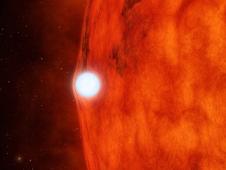A remnant of Kepler’s supernova was recently observed with NASA’s Chandra X-ray Observatory. The supernova is the famous explosion that was discovered by Johannes Kepler in 1604. The red, green and blue colors in the image show low, intermediate and high energy X-rays observed with NASA’s Chandra X-ray Observatory.
As reported in a NASA press release, a new study has used Chandra to identify what triggered the explosion. It had already been shown that the type of explosion was a so-called Type Ia supernova, the thermonuclear explosion of a white dwarf star. These supernovas are important cosmic distance markers for tracking the accelerated expansion of the Universe.
This study is an excellent extension to the NASA Explorer Schools featured lesson, Algebraic Equations: Transit Tracks—Finding Habitable Planets. To access this lesson, visit the NES Virtual Campus.
To see the spectacular image of the Kepler supernova remnant and read more about this discovery, visit Chandra’s Exploring the Invisible Universe website.
 Rebecca Wood from Lebanon Middle School in Lebanon, Kentucky introduces this NASA Now program.
Rebecca Wood from Lebanon Middle School in Lebanon, Kentucky introduces this NASA Now program.
 NASA’s Kepler space telescope has witnessed the effects of a dead star bending the light of its companion star. The findings are among the first detections of this phenomenon — a result of Einstein’s theory of general relativity — in binary star systems.
NASA’s Kepler space telescope has witnessed the effects of a dead star bending the light of its companion star. The findings are among the first detections of this phenomenon — a result of Einstein’s theory of general relativity — in binary star systems. 